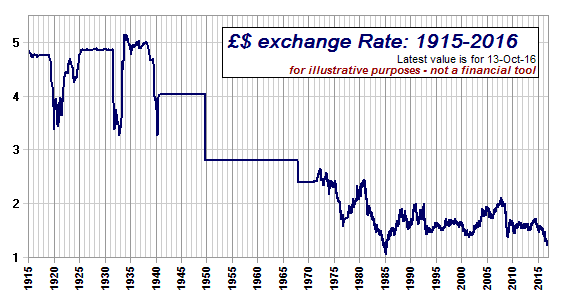Dollar History
1: from 1915
2: from
1940
3: from
1971
4: from
2008
Last update
(excluding graph):
9-Apr-2013
©1996-2013
Mike Todd
![]()
A
graphical history of the
Dollar Exchange Rate
1:
1915-1940
This page starts a 4-page history of the pound/dollar exchange rate (with graphs) from around 1915. There are also pages describing the rates from 1940, from 1971 and also for the past few years (all of which I try to keep as up-to-date as I can).
Although I have done my best to research and present the details from numerous different sources as accurately as I can, the subject is, at times, extremely complex, and I'm certainly no expert in fnance. Therefore, it's important to note that all the information provided on these pages is for information only.
Please don't contact me for advice or rely on information here for financial decisions - there are a number of commercial foreign exchange Web sites that will give you the necessary detail. Nevertheless, I hope that you will find the information on this, and the following three pages, of interest.
The
early days to World War I
Initially, there
was no such thing as an official "exchange rate". Instead,
gold was used to fix countries' currency values, and governments would
determine just how much it would cost to convert one ounce of gold into
their currency. In order toexchange
pounds for dollars, one would have to buy gold in Britain, transport
it to America (with all the costs that this would entail), and then
sell it for its worth in dollars.
So, while there was no official exchange rate as such, the amount of dollars that you would get for your pounds would depend on the price of gold in the two countries. This is the basic principle behind the "Gold Standard".
However, countries haven't always stuck to the Gold Standard. There have been variations on this system, including pegging one currency to another, but when this sort of link is removed, and free-trading is permitted, rates can vary significantly as the demand for each currency varies.
In the 18th century, the pound was fixed to a Gold Standard, and Britain then abandoned it, only to go back in 1821. Then, at the outbreak of war, in 1914, restrictions were placed on the export of gold and Britain reverted to inconvertible paper monry (that is, money that could not be converted to gold, and vice versa). The result was a "free market" in currency.
 The
graph here starts in 1915, showing that there was some stability up
to 1919, with the pound worth around $4.70, after which the value of
the dollar dropped, followed by the typical variability of an upegged
currency.
The
graph here starts in 1915, showing that there was some stability up
to 1919, with the pound worth around $4.70, after which the value of
the dollar dropped, followed by the typical variability of an upegged
currency.
Then, in 1925, Britain re-adopted a form of the Gold Standard, and the £/$ rate was again determined by the relative values of gold in the two countries, with the rate becoming fixed at around $4.87.
But this high value of the pound, compared with what it had been over the previous ten years put the UK's balance of payments under stress, and created a run on the pound. Many steps were taken to try to prevent economic collapse, including borrowing money from New York and Paris. In the end, the UK left the Gold Standard in September of 1931, and the floating pound dropped quickly to around $3.69
Over the following year or so, confidence in the pound recovered, and America felt the pressure which resulted in their devaluing the dollar in 1933, and the pound shot up to its highest ever value, with one pound able to buy $5 in 1934.
By 1937 every country in the world had abandoned the Gold Standard, and the £/$ rate hovered around the $5 mark for several years. But the impending crisis in 1939 saw the value of the pound start to drop, and at the outbreak of World War II the rate dropped from $4.61 to $3.99 within a month. In March, 1940, the British government took the decision to peg the value of the pound to the dollar, at $4.03, where it stayed for several years (although there was a parallel "free" market for currency which saw the pound drop to $3.27 in May, 1940, before it settled back close to the official rate in September).
| << The dollar exchange rate from 2006 |